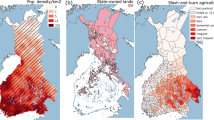Abstract
One of the primary materials for the study of forest landscapes of the Kanto region in the 1880fs is a set of topographic maps which were made for the first time ever in Japan to cover a wide area based on a modern survey. The other primary material is a set of records which were written as supplementary explanations of these maps. The results show that most of the forests there at that time, other than special ones such as national forests, consisted predominantly of pine trees or deciduous oak trees, and that most pine trees in the forests were less than 10 meters in height while most deciduous oak forests were less than 4 meters in height. Intensive use for fuel etc. on a rotation of 4 to 30 years was the background of such forests.
Access this chapter
Tax calculation will be finalised at checkout
Purchases are for personal use only
Preview
Unable to display preview. Download preview PDF.
Similar content being viewed by others
References
Chiba, T. (1991): A study of bald hills (Hageyama no kenkyu), Soshiete, Tokyo, 349p. (in Japanese)
Honda, S. (1908): Silviculture (Zoringaku honron), Miura Shoten, Tokyo, 227p. (in Japanese)
Ishii, M., Ueda, K. & Shigematsu, T. (1993): Conservation of satoyama forests (Satoyama no shizen wo mamoru), Tsukijishokan, Tokyo, 171p. (in Japanese)
Moriyama, H. (1988): How to conserve nature (Shizen wo mamoru towa doiu koto ka), Nobunkyo, Tokyo, 260p. (in Japanese)
Ogura, J. (1992): History of vegetation and man (Hito to keikan no rekishi), Yuzankaku, Tokyo, 238p. (in Japanese)
Ogura, J. (1993): A study of the vegetation marks of the maps called Jinsokuzu, Journal of Kyoto Seika University, No.5, pp.40–69. (in Japanese with English summary)
Ogura, J. (1996): Vegetation and lives of Japanese (Shokusei kara yomu nihonjin no kurashi), Yuzankaku, Tokyo, 246p. (in Japanese)
Rikugun-bunko, (1881): Criteria for the military survey (Heiyo sokuryo kiten), Rikugun-bunko, Tokyo, 370p. (in Japanese)
Author information
Authors and Affiliations
Editor information
Editors and Affiliations
Rights and permissions
Copyright information
© 1998 Springer Science+Business Media Dordrecht
About this chapter
Cite this chapter
Ogura, Ji. (1998). Forest Landscapes of the Kanto Region, Japan in the 1880’s and Human Impact on Them. In: Sassa, K. (eds) Environmental Forest Science. Forestry Sciences, vol 54. Springer, Dordrecht. https://doi.org/10.1007/978-94-011-5324-9_16
Download citation
DOI: https://doi.org/10.1007/978-94-011-5324-9_16
Publisher Name: Springer, Dordrecht
Print ISBN: 978-94-010-6237-4
Online ISBN: 978-94-011-5324-9
eBook Packages: Springer Book Archive




